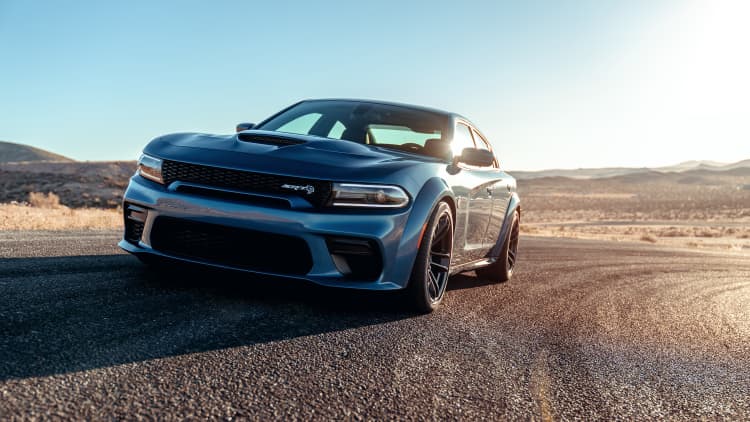DETROIT – Dodge has kept American muscle cars alive more than any other brand in the U.S. auto industry during the past decade, leading to a cult following that kept retail sales of its car-heavy lineup in the black last year during the coronavirus pandemic.
But vehicles such as its infamous Hellcat models with supercharged V-8 engines that crank out more than 700 horsepower – double that of most mainstream vehicles – will eventually have to come to an end due to tightening fuel economy requirements and the rise of electric vehicles.
The situation is something Dodge CEO Tim Kuniskis, an icon among gearheads for the Hellcat models, is well aware of … and surprisingly not afraid of happening.
"The days of an iron block supercharged 6.2-liter V-8 are numbered," he told CNBC during a recent video interview, referring to engines such as the Hellcat. "They're absolutely numbered because of all the compliance costs. But the performance that those vehicles generate is not numbered."

Kuniskis, who first introduced the Dodge Hellcat Challenger in 2014, believes electrification – whether its hybrids with a less powerful engine or all-electric vehicles – will actually save what he has called the new "Golden Age of muscle cars." He calls electrification "Performance 2.0," and he predicts it will occur once EV technologies come down in price and become more mainstream.
"The whole world is going to shift to electrification, right? We know this is coming," he said. "The whole world's going get there and when it does, the price point of that technology is going to come down and … the crazy people are going to take the electrification that has now become accessible from a price point and make that performance-based instead of economy-based."
Dodge's current lineup includes a two-door Challenger coupe, four-door Charger sedan and Durango SUV. All offer Hellcat variants with more than 700 or 800 horsepower and top speeds ranging from 180 mph to more than 200 mph.
Surpassed expectations
Kuniskis' comments may surprise industry onlookers. Dodge's $70,000-plus Hellcat models have become halos for the brand, meaning they attract tremendous amounts of attention that result in trickle-down sales for less-expensive vehicles. Most recently, a limited-edition Hellcat version of its Dodge Durango SUV sold out for the 2021 model-year.
"What Hellcat has done is way beyond what our initial expectations were because it's way beyond what a traditional, very high-end trim does," Kuniskis said. "In the last five years or so, we've sold well over 50,000 Hellcats. That's a lot of Hellcats in five years if you think about you know the price point of that car."
Kuniskis defends electrification being the savior of vehicles like the Hellcats by looking back at how the first so-called Golden Age of muscle cars during the 1960s and early 1970s came to an end. Such vehicles were a grass roots phenomenon, followed by automakers making them, which led to government regulations. Automakers overwhelmingly were forced to discontinue such vehicles for more fuel-efficient models with less performance.
"1972 was the beginning of the end of the Golden Age of muscle cars," Kuniskis said. "They went away for fuel economy, for the oil crisis. They went away for safety. They went away for insurance, and they went away for increasing emission standards. It's kind of crazy to think about we're getting close to a similar list of things right now."
The Biden administration is expected to tighten fuel economy standards, promote the adoption of EVs and be far less supportive of the oil industry, which could potentially lead to higher prices. At the same time, automakers are developing self-driving vehicles that have no need for a driver of the performance of a muscle car.
"So is this 1972 right now and we just don't know it because we're just drunk on the horsepower? I worry about that every single day because think about how long it took us to get here," Kuniskis said, citing the decades-long progression of the horsepower of cars to what Dodge and other manufacturers offer today.
Dodge's Hellcat models have assisted the brand in its sales since being introduced in 2014. Sales of its Charger have regularly topped 80,000 or 90,000, while sales of the 1970s-inspired Challenger have surpassed General Motors' Chevrolet Camaro every year since 2018. Ford Motor's Mustang remains the top-seller of two-door coupes from the Detroit automakers.
EV plans
Dodge's former parent company Fiat Chrysler, which became Stellantis through a $52 billion merger with French automaker Groupe PSA on Jan. 16, has been far slower than many in adopting electrification.
Dodge has no all-electric or plug-in hybrid vehicles. Kuniskis said that will change but declined to offer additional details.
"I'm super excited about the future of electric because I think it's what's going to allow us to not fall off the cliff.," he said. "Without that technology, without electrification. This is 1972 right now, this thing is going to end."

Stellantis CEO Carlos Tavares told reporters last week that every new vehicle the automaker launches from now until 2025 will offer an "electrified" variant, including 10 new models globally in 2021.
Stellantis — now the world's fourth-largest automaker — was formed largely to assist the smaller automakers with investing in emerging technologies such as electric and autonomous vehicles.
Ahead of the merger finalizing a week ago, Kuniskis said that Stellantis' 14 brands — ranging from European units such as Maserati, Peugeot and Fiat to America's Jeep, Ram Trucks and Chrysler — will allow Dodge to remain a performance brand in the upcoming age of EVs.
"We have all these different brands, which allows us to be very focused on what the positioning of that brand is," he said. "I don't have to be kind of generic ... All I do is American muscle so my marketing and everything that I do can be very focused on exactly that."


